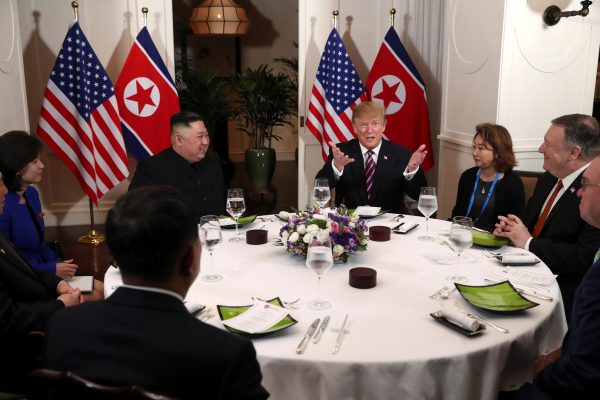The June 2018 summit in Singapore was the first time a sitting US president has met with a North Korean leader. Trump and Kim signed an agreement that included a pledge to denuclearise the Korean Peninsula, committing the United States and North Korea to working toward ‘peace and prosperity’.
But following the summit, Trump came under fire for not extracting guarantees from Pyongyang on the specifics of ‘denuclearisation’. Critics argued that promises to disarm were inadequate, as North Korea had advanced its ballistic and nuclear programs to the point where a testing pause made little difference.
The Trump administration countered that the summit was not supposed to solve the nuclear crisis, but rather set conditions for future talks in which North Korea would give up its nuclear arsenal in exchange for economic incentives.
Despite continued goodwill, there has been no forward momentum on either side. Washington refuses to lift sanctions and Pyongyang reportedly continues to develop its nuclear weapons program. As such, negotiations have languished.
The second Trump–Kim summit was expected to break the diplomatic stalemate and reignite the impetus for denuclearisation. Instead, the impasse remains.
While the Trump administration sought ‘complete, verifiable, irreversible’ denuclearisation (CVID) at the first summit, they came to the second summit more flexible and willing to listen. Trump stated that he wanted denuclearisation, but was in no rush. He praised the importance of his ‘personal relationship’ with Kim and took credit for the United States and North Korea avoiding a major war.
For Pyongyang, the Singapore summit bought Kim international legitimacy and the suspension of US–South Korea joint military exercises. Kim left Singapore confident that US pressure had been defused.
Easing sanctions was at the top of Kim’s Hanoi wish list. To achieve his goal and to provide evidence of a commitment to denuclearisation, Kim proposed shutting down and dismantling the Yongbyon nuclear facilities. Negotiations collapsed on this point — Yongbyon was not enough of a bargaining chip.
Trump claimed that Kim asked to eliminate the entire sanctions regime in exchange for the closure of Yongbyon. Such an agreement would have gone against the longstanding US position of CVID as a precondition for ending economic pressure on North Korea. But North Korean Foreign Minister Ri Yong Ho subsequently contradicted Trump, saying that North Korea had asked only for the partial lifting of sanctions, following the step-by-step approach favoured by Pyongyang.
Despite conflicting accounts, one point was clear: the leader-to-leader diplomatic approach had failed to bridge the gap between the United States and North Korea, prompting a new stalemate.
Perhaps the biggest ramifications for the breakdown of talks come in third-party nations.
In South Korea, Moon has been a mediator of US–North Korea rapprochement and is wagering considerable political capital on mending ties with North Korea. Moon’s popularity, at an all-time high in 2018, is now struggling amidst an economic slump. While US participation in inter-Korean reconciliation keeps domestic opposition to this process in check, the disappointment of the Hanoi summit will provide new impetus to the conservative opposition in South Korea. To manage these repercussions, Moon will likely resume his role as mediator.
China, meanwhile, was conspicuously quiet on the Hanoi summit. This should not be misunderstood as a lack of interest. Beijing has a vested interest in both the stability of its eastern borders and its influence on the Korean Peninsula.
With Chinese support, North Korea weathered a battery of economic sanctions. Chinese President Xi Jinping met Kim four times over the past year, most recently in January. China is unlikely to oppose plans for a denuclearised Korean Peninsula but will press for an accompanying reduction of US troops in the region.
North Korea is unlikely to offer more than the dismantling of Yongbyon in current negotiations. Without a more substantial sign that Pyongyang is ready to decommission its nuclear program, Trump will be less willing to spend precious political capital on meeting with Kim — especially as the 2020 US presidential elections approach.
While Hanoi might be seen as a disappointment, all is not lost. Despite initial US opposition, a gradual approach still represents the best path forward. This requires focusing on more realistic goals: a commitment to officially end the Korean War, limited but substantial steps in terms of North Korea’s denuclearization and a gradual relaxation of economic sanctions.
Markus Bell is a lecturer in Korean studies at the University of Sheffield.
Marco Milani is a lecturer in Korean studies at the University of Sheffield.
A version of this article originally appeared here on AsiaGlobal Online.


The last paragraph offers a road map that is viable. But it requires that Trump exhibit qualities that he has so far not demonstrated: a grasp of the bigger picture with the patience, persistence, and willingness to coordinate with allies towards achieving longer term goals. For example, how can he get China to really buy in when he is engaged in a trade war at the same time?
Don’t hold your breath waiting!